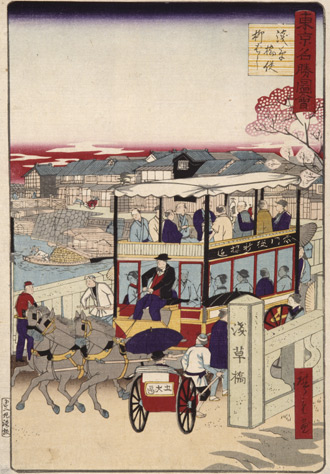Fr : version française / En: english version

Upstairs only!
In order to accommodate omnibus networks, cities had to adapt: streets had to be widened, public money had to be invested to bring fares down, and attitudes had to change. Expectations were high but many were disillusioned: the omnibuses were often full and journeys slow and expensive. The invention of the double-decker omnibus, on which it was cheaper to travel on the open top deck, increased the carrying capacity without taking up more road space, although it did not solve everything.
"It is always difficult to drive fast in the city in the middle of the day, when the streets are full of traffic, but we did what could be done; [...] I had a very good mouth -- that is I could be guided by the slightest touch of the rein; and that is a great thing in London, among carriages, omnibuses, carts, vans, trucks, cabs, and great wagons creeping along at a walking pace; some going one way, some another, some going slowly, others wanting to pass them; omnibuses stopping short every few minutes to take up a passenger, obliging the horse that is coming behind to pull up too, or to pass, and get before them; perhaps you try to pass, but just then something else comes dashing in through the narrow opening, and you have to keep in behind the omnibus again; presently you think you see a chance, and manage to get to the front, going so near the wheels on each side that half an inch nearer and they would scrape. Well, you get along for a bit, but soon find yourself in a long train of carts and carriages all obliged to go at a walk; perhaps you come to a regular block-up, and have to stand still for minutes together, till something clears out into a side street, or the policeman interferes; you have to be ready for any chance -- to dash forward if there be an opening, and be quick as a rat-dog to see if there be room and if there be time, lest you get your own wheels locked or smashed, or the shaft of some other vehicle run into your chest or shoulder. All this is what you have to be ready for. If you want to get through London fast in the middle of the day it wants a deal of practice."
Extract from Black Beauty by Anna Sewell, Chapter 35, Jerry Barker
Famous views of Tokyo series
This print is one of a series of famous views of Tokyo, itself a revisiting of a series by the same name done some forty years previously by Utagawa Hiroshige, his master and father-in-law. At this time, Tokyo was already a megalopolis of over a million people and public transportation was therefore essential. As was his custom, Hiroshige III shows the shift towards Western ways that Japan embarked upon in the late 19th century. Many of his prints show an electricity pole in the foreground, like the photos that modern tourists take in Japan. One notices that the coachman of this omnibus and some of the passengers are wearing Western-style hats.
Hiroshige III Utagawa
Hiroshige III, whose real name was Ando Tokubei, was a Japanese painter, draftsman and engraver, born in Tokyo in 1842 to a carpenter father, though later adopted by an art restorer. He met the engraver Utagawa Hiroshige and became his second pupil as well as his second son-in-law, and changed his name several times as was customary among Japanese painters. Hiroshige III was very active after the death of his master in 1865, a time when Japan was opening up to the West. His nishiki-e prints (polychrome woodcuts) show the profound changes sweeping through the country and promote Japanese artisans. He died in 1894.










